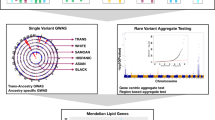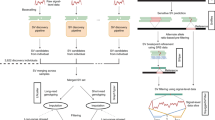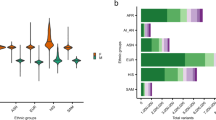Abstract
We describe initial steps for interrogating whole-genome sequence data to characterize the genetic architecture of a complex trait, levels of high-density lipoprotein cholesterol (HDL-C). We report whole-genome sequencing and analysis of 962 individuals from the Cohorts for Heart and Aging Research in Genetic Epidemiology (CHARGE) studies. From this analysis, we estimate that common variation contributes more to heritability of HDL-C levels than rare variation, and screening for mendelian variants for dyslipidemia identified individuals with extreme HDL-C levels. Whole-genome sequencing analyses highlight the value of regulatory and non-protein-coding regions of the genome in addition to protein-coding regions.
This is a preview of subscription content, access via your institution
Access options
Subscribe to this journal
Receive 12 print issues and online access
$209.00 per year
only $17.42 per issue
Buy this article
- Purchase on Springer Link
- Instant access to full article PDF
Prices may be subject to local taxes which are calculated during checkout


Similar content being viewed by others
References
Roach, J.C. et al. Analysis of genetic inheritance in a family quartet by whole-genome sequencing. Science 328, 636–639 (2010).
Lupski, J.R. et al. Whole-genome sequencing in a patient with Charcot-Marie-Tooth neuropathy. N. Engl. J. Med. 362, 1181–1191 (2010).
Castelli, W.P. et al. HDL cholesterol and other lipids in coronary heart disease. The cooperative lipoprotein phenotyping study. Circulation 55, 767–772 (1977).
Yang, J. et al. Common SNPs explain a large proportion of the heritability for human height. Nat. Genet. 42, 565–569 (2010).
Yang, J. et al. Genome partitioning of genetic variation for complex traits using common SNPs. Nat. Genet. 43, 519–525 (2011).
Stenson, P.D. et al. Human Gene Mutation Database: towards a comprehensive central mutation database. J. Med. Genet. 45, 124–126 (2008).
Brousseau, M.E. et al. Novel mutations in the gene encoding ATP-binding cassette 1 in four tangier disease kindreds. J. Lipid Res. 41, 433–441 (2000).
Rhyne, J., Mantaring, M.M., Gardner, D.F. & Miller, M. Multiple splice defects in ABCA1 cause low HDL-C in a family with hypoalphalipoproteinemia and premature coronary disease. BMC Med. Genet. 10, 1 (2009).
Weers, P.M. et al. Novel N-terminal mutation of human apolipoprotein A-I reduces self-association and impairs LCAT activation. J. Lipid Res. 52, 35–44 (2011).
Teslovich, T.M. et al. Biological, clinical and population relevance of 95 loci for blood lipids. Nature 466, 707–713 (2010).
Papp, A.C. et al. Cholesteryl ester transfer protein (CETP) polymorphisms affect mRNA splicing, HDL levels, and sex-dependent cardiovascular risk. PLoS ONE 7, e31930 (2012).
Dachet, C., Poirier, O., Cambien, F., Chapman, J. & Rouis, M. New functional promoter polymorphism, CETP/–629, in cholesteryl ester transfer protein (CETP) gene related to CETP mass and high density lipoprotein cholesterol levels: role of Sp1/Sp3 in transcriptional regulation. Arterioscler. Thromb. Vasc. Biol. 20, 507–515 (2000).
Li, Y., Sidore, C., Kang, H.M., Boehnke, M. & Abecasis, G.R. Low-coverage sequencing: implications for design of complex trait association studies. Genome Res. 21, 940–951 (2011).
Romeo, S. et al. Population-based resequencing of ANGPTL4 uncovers variations that reduce triglycerides and increase HDL. Nat. Genet. 39, 513–516 (2007).
Montgomery, S.B. et al. ORegAnno: an open access database and curation system for literature-derived promoters, transcription factor binding sites and regulatory variation. Bioinformatics 22, 637–640 (2006).
Li, H. & Durbin, R. Fast and accurate long-read alignment with Burrows-Wheeler transform. Bioinformatics 26, 589–595 (2010).
Purcell, S. et al. PLINK: a toolset for whole-genome association and population-based linkage analysis. Am. J. Hum. Genet. 81, 559–575 (2007).
Wang, K., Li, M. & Hakonarson, H. ANNOVAR: functional annotation of genetic variants from high-throughput sequencing data. Nucleic Acids Res. 38, e164 (2010).
Wu, M.C. et al. Rare-variant association testing for sequencing data with the sequence kernel association test. Am. J. Hum. Genet. 89, 82–93 (2011).
Griffith, O.L. et al. ORegAnno: an open-access community-driven resource for regulatory annotation. Nucleic Acids Res. 36, D107–D113 (2008).
Cabili, M.N. et al. Integrative annotation of human large intergenic noncoding RNAs reveals global properties and specific subclasses. Genes Dev. 25, 1915–1927 (2011).
Pruitt, K.D., Tatusova, T., Klimke, W. & Maglott, D.R. NCBI Reference Sequences: current status, policy and new initiatives. Nucleic Acids Res. 37, D32–D36 (2009).
Gordon, A., Glazko, G., Qiu, X. & Yakolev, A. Control of the mean number of false discoveries, Bonferroni and stability of multiple testing. Ann. Appl. Stat. 1, 179–190 (2007).
Acknowledgements
Atherosclerosis Risk in Communities (ARIC) Study: This ARIC study is carried out as a collaborative study supported by NHLBI contracts HHSN268201100005C, HHSN268201100006C, HHSN268201100007C, HHSN268201100008C, HHSN268201100009C, HHSN268201100010C, HHSN268201100011C and HHSN268201100012C. The authors thank the staff and participants of the ARIC study for their important contributions. Ancillary study support has been provided by NHLBI-sponsored project RC2HL102419-02.
Cardiovascular Health Study (CHS): This CHS research was supported by NHLBI contracts N01-HC-85239, N01-HC-85079 through N01-HC-85086, N01-HC-35129, N01 HC-15103, N01 HC-55222, N01-HC-75150, N01-HC-45133 and HHSN268201200036C and by NHLBI grants HL080295, HL087652 and HL105756, with additional contribution from the National Institute of Neurological Disorders and Stroke (NINDS). Additional support was provided through AG-023629, AG-15928, AG-20098 and AG-027058 from the National Institute on Aging (NIA). See also https://chs-nhlbi.org/CHSOverview.
Framingham Heart Study (FHS) of the NHLBI of the US National Institutes of Health and Boston University School of Medicine: This work was supported by the NHLBI FHS (contract N01-HC-25195).
Author information
Authors and Affiliations
Consortia
Contributions
J.Y., D.M., F.Y., E.B. and R.G. were responsible for the design and implementation of the whole-genome sequencing and variant calling. A.L. and K.R. contributed to the analysis of mendelian variation. X.L. and C.Z. contributed to the estimation of heritability. A.C.M., A.V. and A.D.J. performed statistical analysis of the whole-genome sequence and phenotype data. G.H., C.J.O. and B.M.P. were involved in participant recruitment, consenting and examination. A.C.M., A.V., A.D.J., X.L., J.B., G.H., C.J.O., B.M.P., L.A.C., R.G. and E.B. jointly conceived the study and contributed to preparation and editing of the manuscript.
Corresponding author
Ethics declarations
Competing interests
B.M.P. serves on the Data and Safety Monitoring Board for a clinical trial of a device funded by the manufacturer (Zoll LifeCor) and on the Steering Committee of the Yale Open Data Access Project funded by Medtronic.
Supplementary information
Supplementary Text and Figures
Supplementary Figures 1–11, Supplementary Tables 1–7, Supplementary Note (PDF 412 kb)
Rights and permissions
About this article
Cite this article
the Cohorts for Heart and Aging Research in Genetic Epidemiology (CHARGE) Consortium. Whole-genome sequence–based analysis of high-density lipoprotein cholesterol. Nat Genet 45, 899–901 (2013). https://doi.org/10.1038/ng.2671
Received:
Accepted:
Published:
Issue Date:
DOI: https://doi.org/10.1038/ng.2671
This article is cited by
-
Improved power and precision with whole genome sequencing data in genome-wide association studies of inflammatory biomarkers
Scientific Reports (2019)
-
Die Rolle seltener Varianten bei häufigen Krankheiten
Medizinische Genetik (2019)
-
Methods to evaluate rare variants gene-age interaction for triglycerides
BMC Proceedings (2018)
-
Genetic variants in microRNA genes and targets associated with cardiovascular disease risk factors in the African-American population
Human Genetics (2018)
-
Genetic–epigenetic interactions in cis: a major focus in the post-GWAS era
Genome Biology (2017)



